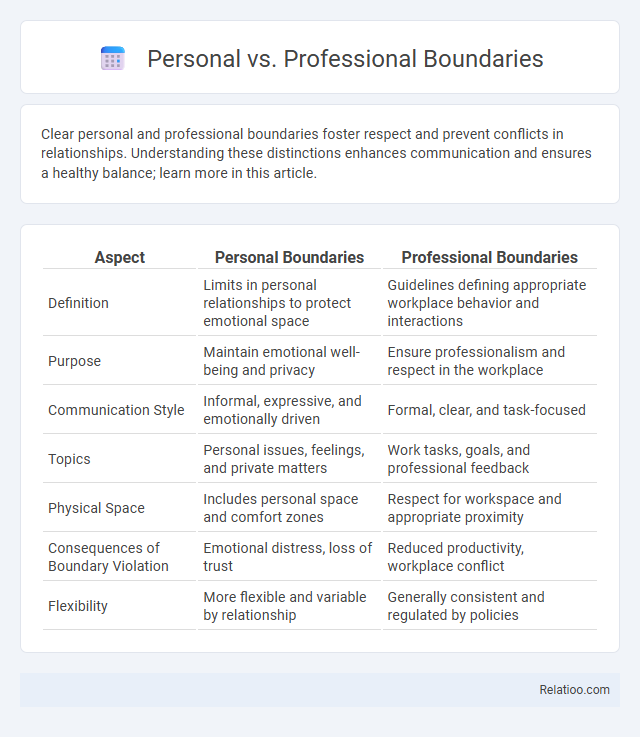Clear personal and professional boundaries foster respect and prevent conflicts in relationships. Understanding these distinctions enhances communication and ensures a healthy balance; learn more in this article.
Table of Comparison
| Aspect | Personal Boundaries | Professional Boundaries |
|---|---|---|
| Definition | Limits in personal relationships to protect emotional space | Guidelines defining appropriate workplace behavior and interactions |
| Purpose | Maintain emotional well-being and privacy | Ensure professionalism and respect in the workplace |
| Communication Style | Informal, expressive, and emotionally driven | Formal, clear, and task-focused |
| Topics | Personal issues, feelings, and private matters | Work tasks, goals, and professional feedback |
| Physical Space | Includes personal space and comfort zones | Respect for workspace and appropriate proximity |
| Consequences of Boundary Violation | Emotional distress, loss of trust | Reduced productivity, workplace conflict |
| Flexibility | More flexible and variable by relationship | Generally consistent and regulated by policies |
Understanding Personal and Professional Boundaries
Understanding personal and professional boundaries is essential for maintaining respectful and effective interactions in both your private life and workplace. Personal boundaries define your emotional and physical limits, protecting your well-being, while professional boundaries establish clear expectations for behavior and responsibilities within professional settings. Maintaining these boundaries helps prevent conflicts, promotes trust, and enhances communication in all areas of your life.
Defining Personal Boundaries in Daily Life
Personal boundaries are essential guidelines that help you protect your emotional well-being and maintain healthy relationships by clearly defining what is acceptable in your interactions. These boundaries involve recognizing your limits regarding privacy, time, and emotional energy, ensuring respect from others in everyday situations. Establishing firm personal boundaries allows you to create a balance between self-care and social obligations, preventing overcommitment and stress.
Characteristics of Professional Boundaries
Professional boundaries maintain a clear separation between work responsibilities and personal relationships, ensuring respect, trust, and ethical behavior in the workplace. These boundaries are characterized by consistency, confidentiality, and appropriate emotional distance, preventing conflicts of interest and fostering a productive environment. Your adherence to professional boundaries safeguards both your integrity and the wellbeing of clients or colleagues.
Key Differences Between Personal and Professional Boundaries
Personal boundaries define the limits you set in relationships to protect your emotional well-being, while professional boundaries maintain a respectful and productive environment at work. Your personal boundaries often involve feelings, values, and private information, whereas professional boundaries emphasize roles, responsibilities, and appropriate communication. Understanding these key differences helps you balance interactions and maintain healthy relationships both at home and in the workplace.
Why Boundaries Matter: Benefits for Wellbeing
Setting clear personal and professional boundaries enhances mental health by reducing stress and preventing burnout. You maintain healthier relationships and improve focus when defining limits between work responsibilities and personal time. Establishing strong boundaries supports overall wellbeing by promoting balance and ensuring your needs are respected.
Common Challenges in Setting Boundaries
Common challenges in setting personal versus professional boundaries include maintaining clear communication to prevent role confusion and managing emotional involvement while ensuring productivity. Individuals often struggle with balancing empathy and authority, leading to stress or burnout when boundaries are blurred. Lack of consistency and fear of conflict frequently hinder effective boundary enforcement in both personal relationships and workplace settings.
Signs of Blurred or Crossed Boundaries
Signs of blurred or crossed boundaries include sharing excessively personal information in professional settings, frequent socializing beyond work contexts with colleagues, and difficulty saying no to tasks that exceed job responsibilities. Emotional over-involvement, such as relying on coworkers for personal support or frequent oversharing, often indicates weakened distinctions between personal and professional roles. Recognizing these signs helps maintain clear boundaries, preserving workplace professionalism and personal well-being.
Strategies for Establishing Healthy Boundaries
Establishing healthy personal and professional boundaries requires clear communication of limits to prevent overlap and maintain respect. Implementing consistent routines, such as designated work hours and private time, supports boundary reinforcement while reducing stress and burnout. Utilizing tools like setting expectations, prioritizing self-care, and seeking feedback enhances boundary clarity and promotes balanced relationships in both personal and professional settings.
Navigating Boundary Conflicts at Work and Home
Navigating boundary conflicts at work and home requires clear differentiation between personal and professional boundaries to maintain healthy relationships and productivity. Establishing firm limits on communication times, topics of discussion, and emotional involvement helps prevent overlap that can lead to misunderstandings or burnout. You can improve conflict resolution by consistently recognizing when personal issues infringe on professional responsibilities or vice versa, allowing for balanced management of both domains.
Maintaining Balance: Tips for Sustaining Boundaries
Maintaining a healthy balance between personal and professional boundaries involves clear communication, setting realistic expectations, and respecting individual limits to prevent burnout. Techniques such as scheduling specific work hours, creating designated spaces for work and personal life, and practicing assertiveness help reinforce these boundaries effectively. Regular self-assessment and boundary adjustments ensure sustained well-being and productivity across both areas.

Infographic: Personal vs Professional Boundaries
 relatioo.com
relatioo.com